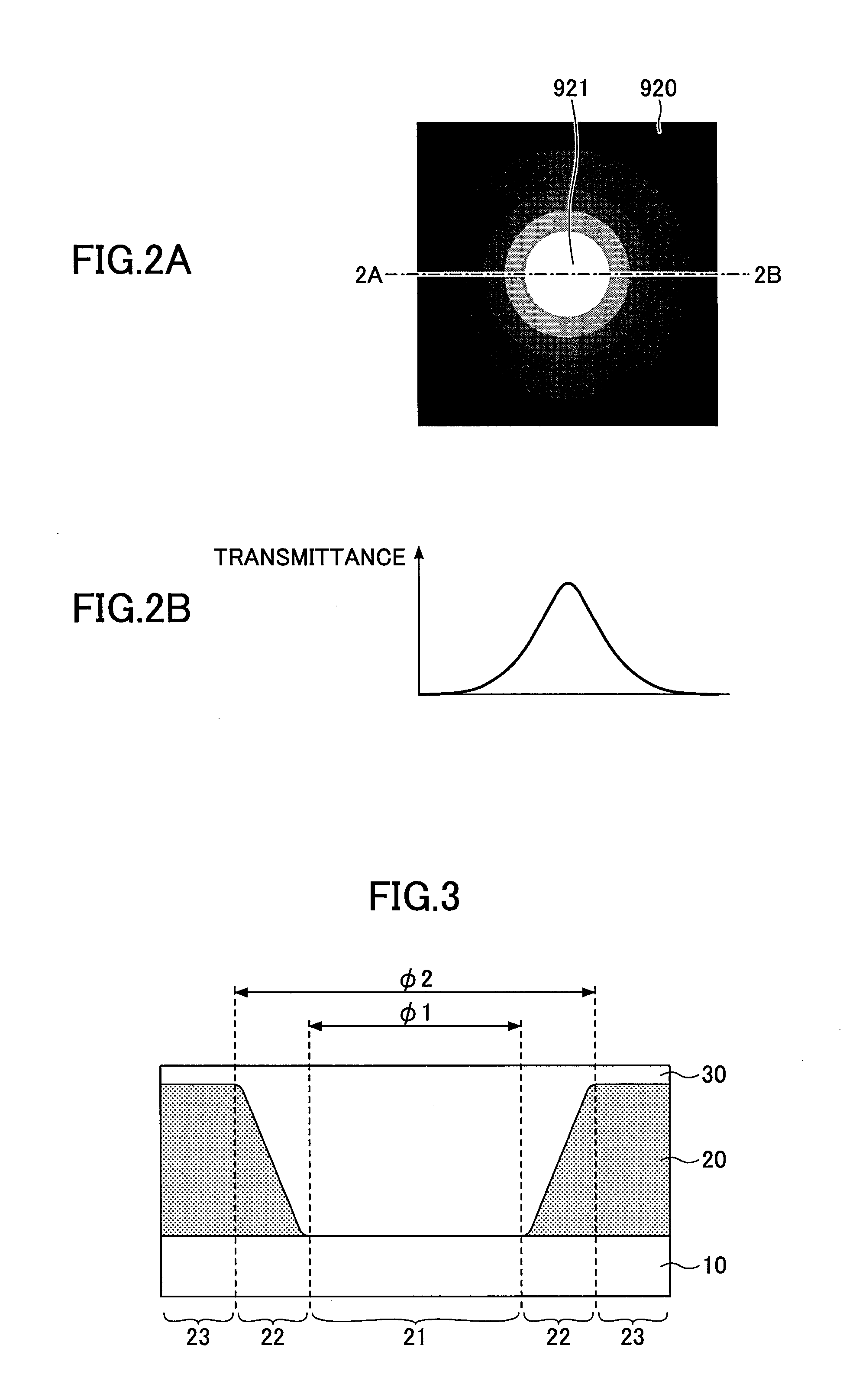Method of producing optical device, optical device, optical system, and imaging device
- Summary
- Abstract
- Description
- Claims
- Application Information
AI Technical Summary
Benefits of technology
Problems solved by technology
Method used
Image
Examples
first embodiment
[0031]A description is given of an optical device according to a first embodiment. The optical device according to this embodiment is a so-called “apodization filter.” Referring to FIGS. 3, 4A and 4B, the optical device includes a transparent base material (substrate) 10 and a light absorbing part 20 and a light transmitting part 30 formed on the transparent base material 10. The transparent base material 10 is formed of a transparent resin material or glass. The light absorbing part 20 is formed of a material that absorbs visible light. The light transmitting part 30 is formed of a material that transmits visible light (a light transparent material). FIG. 4A is a plan view of the optical device according to this embodiment, and FIG. 4B illustrates a light transmittance distribution along one-dot chain line 4A-4B of FIG. 4A.
[0032]The optical device according to this embodiment includes a center region 21 at the center of the optical device, an intermediate region 22 formed around th...
second embodiment
[0058]Next, a description is given of a second embodiment. This embodiment is directed to a method of producing the optical device of the first embodiment. A description is given, with reference to FIGS. 6A through 6F, of a production method of this embodiment, according to which multiple optical devices according to the first embodiment are simultaneously produced.
[0059]Referring to FIG. 6A, first, an appropriate amount of the light absorbing resin material 20a for forming the light absorbing part 20 is dropped onto the transparent base material 10. The light absorbing resin material 20a is a liquid in which an absorbing material is added to a transparent resin material. The light absorbing resin material 20a used in this embodiment is cured through exposure to ultraviolet radiation.
[0060]Next, referring to FIG. 6B, a forming mold 130 having an uneven surface on which irregularities corresponding to the shape of the light absorbing part 20 to be formed is faulted is pressed against...
third embodiment
[0075]Next, a description is given of a third embodiment. This embodiment is directed to a method of producing the optical device of the first embodiment. A description is given, with reference to FIGS. 8A through 8G, of a production method of this embodiment, according to which multiple optical devices according to the first embodiment are simultaneously produced.
[0076]Referring to FIG. 8A, first, an appropriate amount of the light absorbing resin material 20a for forming the light absorbing part 20 is dropped onto the transparent base material 10. The light absorbing resin material 20a is a liquid in which an absorbing material is added to a transparent resin material. The light absorbing resin material 20a is cured through exposure to ultraviolet radiation.
[0077]Next, referring to FIG. 8B, the light absorbing resin material 20a is exposed to ultraviolet radiation. As a result, light absorbing resin material 20a is cured, so that a light absorbing material part 20b is formed.
[0078...
PUM
| Property | Measurement | Unit |
|---|---|---|
| Length | aaaaa | aaaaa |
| Transparency | aaaaa | aaaaa |
| Light | aaaaa | aaaaa |
Abstract
Description
Claims
Application Information
 Login to View More
Login to View More - Generate Ideas
- Intellectual Property
- Life Sciences
- Materials
- Tech Scout
- Unparalleled Data Quality
- Higher Quality Content
- 60% Fewer Hallucinations
Browse by: Latest US Patents, China's latest patents, Technical Efficacy Thesaurus, Application Domain, Technology Topic, Popular Technical Reports.
© 2025 PatSnap. All rights reserved.Legal|Privacy policy|Modern Slavery Act Transparency Statement|Sitemap|About US| Contact US: help@patsnap.com



